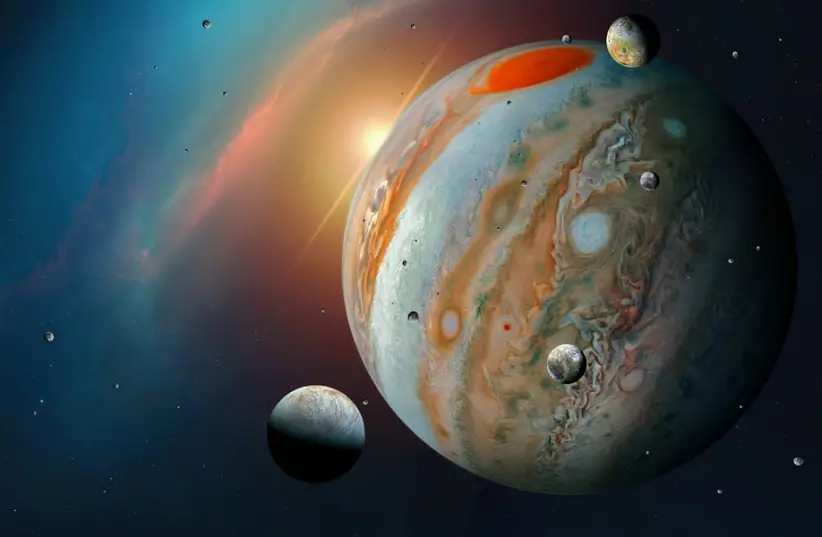
Europa, one of Jupiter’s 79 moons, is both Jupiter’s sixth closest moon and the Solar System’s sixth-largest moon.
It is a dwarf planet with a smooth, frosty surface marred by cracks and fissures. The moon’s surface is a desolate world with an average temperature of 170 degrees Celsius and only a scant atmosphere. However, astronomers suspect that Europa is home to a large ocean beneath its frozen surface, which some scientists believe may harbor extraterrestrial life.
Now, an astronomer has identified evidence for continuous water vapor in Europa’s atmosphere for the first time.
Using the same approach that was recently used to identify water vapor in the atmosphere of Jupiter’s moon Ganymede, an astronomer discovered signs of water in Europa’s trailing hemisphere — the area of the moon constantly facing the opposite direction of its motion.
Previous investigations using computer calculations predicted the uneven distribution of water vapor, but it had not been observed earlier.
“The detection of water vapor on Ganymede and on Europa’s trailing side increases our understanding of the atmospheres of icy moons,” said Lorenz Roth of Sweden’s KTH Royal Institute of Technology. “The observation of a consistent H2O abundance on Europa is remarkable given the planet’s extremely low surface temperatures.”
Roth delves into archival Hubble datasets to achieve this discovery, picking ultraviolet images of Europa from 1999, 2012, 2014, and 2015 while the moon was in various orbital positions.
All of these observations were made using the Space Telescope Imaging Spectrograph, one of Hubble’s most flexible instruments (STIS). Roth was able to determine the quantity of oxygen — one of the elements of water — in Europa’s atmosphere using these ultraviolet STIS measurements, and by interpreting the strength of emission at various wavelengths, he was able to deduce the presence of water vapor.
Observations of water vapor on Europa in the past have been related with ephemeral plumes erupting through the ice, similar to geysers on Earth but towering over 100 kilometers in height. These plume studies observed what appeared to be temporary inhomogeneities or blobs in the atmosphere.
However, the new findings indicate that equal levels of water vapor are present throughout a greater area in observations spanning the years 1999 to 2015. This shows that a water vapor atmosphere has existed on Europa’s trailing hemisphere for an extended period of time. Despite the presence of water vapor on Europa’s trailing hemisphere, no evidence of H2O exists on Europa’s leading hemisphere.
Space scientists attempting to comprehend these ice moons will soon have a close-up view. The European Space Agency’s Jupiter Ice Moons Explorer (JUICE) mission is now preparing for a journey to Jupiter’s three largest icy moons, Ganymede, Callisto, and Europa.
JUICE is the first large-class mission in the European Space Agency’s Cosmic Vision 2015–2025 program, scheduled to launch in 2022 and arrive at Jupiter in 2031. The probe will carry a sophisticated suite of equipment — the most powerful remote sensing payload yet deployed to the outer Solar System — and will spend at least three years observing the Jovian system in detail.
Europa will also be visited by NASA’s Europa Clipper mission, which will conduct a series of flybys of the moon to assess its habitability and pick a landing site for a future expedition.
“This result provides the framework for future science on the Jovian moons,” Roth said. “The more we learn about these frozen moons prior to the arrival of spacecraft such as JUICE and Europa Clipper, the more efficient we can make use of our short observing time within the Jovian system.”
This discovery, together with the knowledge gained from future missions such as JUICE, will help us gain a better understanding of potentially habitable habitats throughout the Solar System. Understanding Jupiter’s birth and development also enable scientists to acquire understanding about Jupiter-like exoplanets orbiting other stars. When combined with data from space telescopes such as the forthcoming NASA/ESA/CSA James Webb Space Telescope, this research could aid scientists in determining if life could exist in Jupiter-like exoplanetary systems elsewhere in the cosmos.




